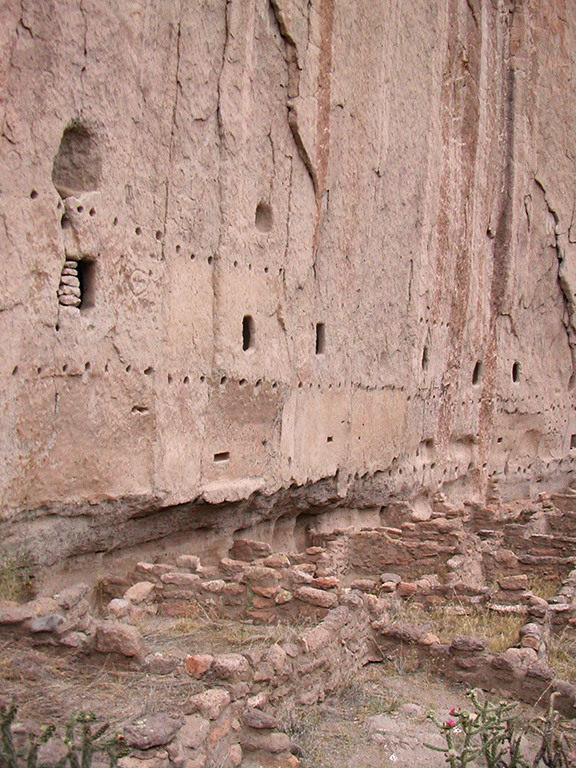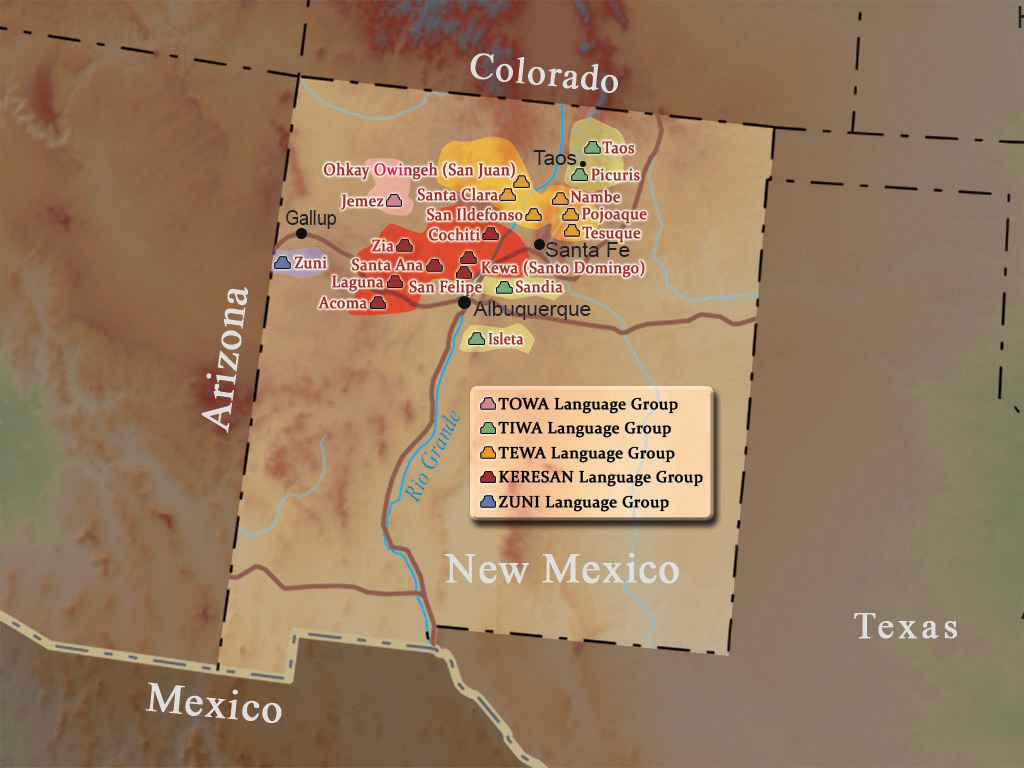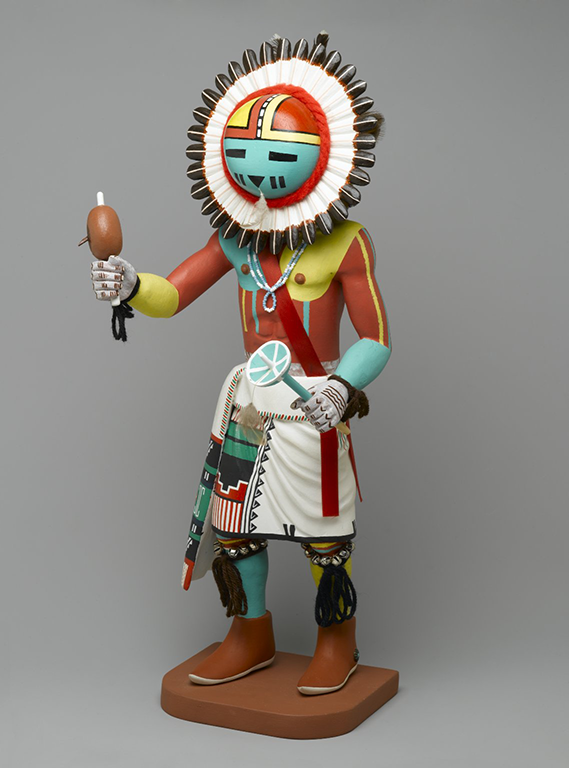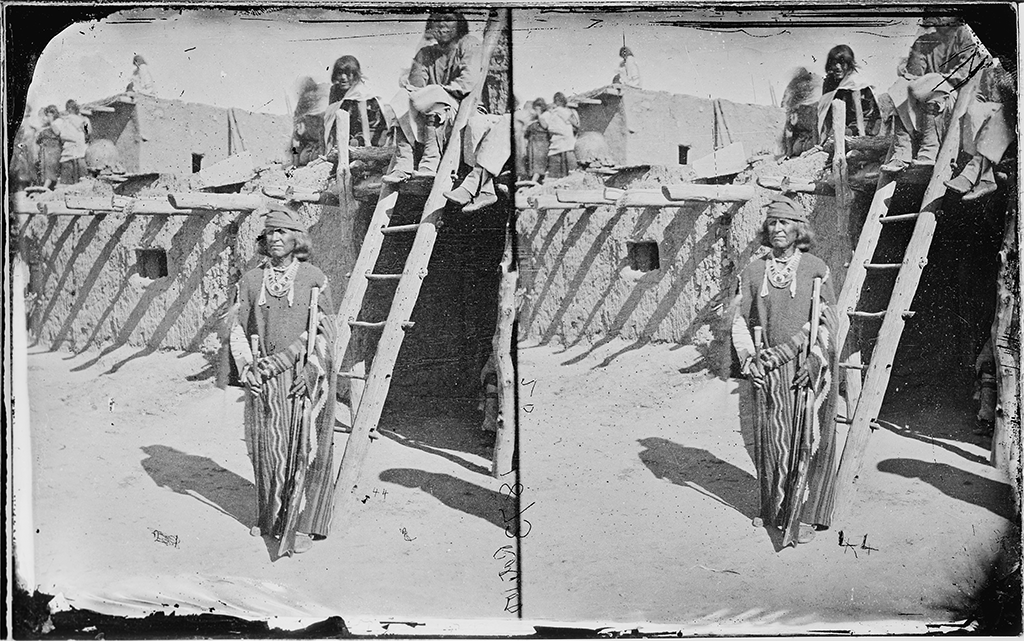The History of New Mexico
Collapse
Expand
-
Chapter 2: New Mexico's First Peoples
- New Mexico's First Peoples
- Recovering First Peoples' Humanity
- Ancient Culture Regions
- Development of Pueblo Society
- Athabaskan Peoples
- Eve of the Spanish Invasion
- References & Further Reading
Migrations away from the centers of Mogollon and Ancestral Puebloan culture led the people, in smaller groups, to the river systems that feed the Rio Grande. Because out-migrations occurred over time and in waves, latecomers found that the river zones were already inhabited. Their arrival led to overcrowding in a few cases. As the migrants formed new villages with the native inhabitants of their chosen sites of refuge, new dialects, cultures, and artistic forms began to develop. Zuni culture coalesced along the Zuni River, Acoma Pueblo was founded near the Rio San José and Rio Puerco, and dozens of other villages took shape within the Rio Grande corridor itself. In sum, the migration left New Mexico with two major population zones: one in the Rio Grande Valley and another along an east-west axis that connected Acoma, Zuni, and Hopi villages.

Photograph by Jacob Rus
Archaeologists refer to the transitional time between 1250 and 1400 as the Rio Grande Classic Period. Some have considered this an era in which Puebloan peoples moved backward rather than forward. Yet, it is more accurately viewed as a time of adaptation. Once again, the people began to build housing structures, although they were smaller in scale than the great houses at Chaco Canyon and Mesa Verde. The structures that are today preserved at Bandelier National Monument and the Puyé Cliff Dwellings are well-known examples. At these sites, towns were laid out around a central plaza and a system of streets. This type of organization was quite different than the earlier Ancestral Puebloan habitations. Another important change was that open courtyards housed each Pueblo’s kiva. Some of these locations were abandoned in the early 1400s in favor of villages nearer to the Rio Grande.
Pueblo cultures hit a peak between 1400 and 1530, a period that has been dubbed the Pueblo Golden Age. As always, we must ask the question of how we know what we know about the way in which Pueblo societies took shape during this time frame. In addition to archaeological and oral history evidence, Spanish accounts add to our knowledge of the Pueblo Golden Age. Those that accompanied the Coronado Expedition were fascinated with the people they found in New Mexico, but they were unable to accept or understand Pueblos’ lifeways on their own terms. Spanish sources, then, must be read with a critical eye. Their biases and feelings of cultural superiority color the ways in which they wrote of New Mexico’s First Peoples. If approached skeptically, however, Spanish accounts add texture to our understanding of early Pueblo peoples.

When the first Europeans arrived in New Mexico, they found between seventy-five and eighty different towns that covered an area from the Piro villages of the middle Rio Grande to Taos in the north, and the Acoma, Zuni, and Hopi villages to the west and Cicuye (Pecos Pueblo) to the east. They were impressed that these people had organized themselves into towns based on agricultural production. For that reason, they referred to the people and their towns alike as Pueblos (the Spanish word for towns). The Europeans could relate to sedentary patterns of living, and settled peoples were easiest for them to subdue. Nomadic peoples, on the other hand, puzzled them and were much harder to conquer. The Pueblos, then, were in many ways a welcome sight, despite their failure to measure up to Spanish dreams of grandeur and wealth.
Despite the single label placed upon New Mexico’s indigenous peoples, they were not a unified group. The nineteen Pueblos of present-day New Mexico provide clues about the ways in which their ancestors’ languages and cultures developed. Although all of the Pueblo peoples share similar ways of life, beliefs, customs, philosophies, and a common economy, they “have an independence similar to that of nations.”4 Each Pueblo continues to project its own unique identity and distinctive features. One of the most significant differences between the Pueblos is their spoken language. The inhabitants of the nineteen remaining Pueblos speak distinct dialects that fall within three major linguistic groups. The Zuni language is unique to the people of the same name. It is considered a language isolate, meaning that it is unrelated to any other known language. Keresan (or Keres) is spoken by the Acoma, Cochiti, Laguna, San Felipe, Santa Ana, Santo Domingo, and Zia peoples with little variation in dialect. The Tanoan language group includes three distinct dialects: Tiwa, Tewa, and Towa. Tiwa is spoken at Isleta, Picuris, Sandia, and Taos. Tewa is spoken at Nambe, Pojoaque, Santa Clara, San Ildefonso, San Juan, and Tesuque. Towa is unique to the Jemez Pueblo.
Due to the diversity of languages spoken in the region, Pueblo peoples were multilingual prior to and following Spanish contact. The Hopi people were also considered to be part of the Pueblo world, although they are not typically included with New Mexico’s Pueblos today. They belong to a different jurisdiction under U.S. Federal Law and their homes lay far to the west. They have traditionally followed their own unique cultural and social trajectory due to their isolation from other Pueblo peoples. Such distance, however, does not mean that Hopis remained (or remain) completely apart from the others. The group of Hopis known as the Tewas of First Pueblo were originally Tano people that fled from Galisteo and San Cristóbal following the return of the Spaniards in 1693.
The names of contemporary Pueblos reflect the extent to which we continue to view them through a Spanish lens. In accordance with their desire to conquer and colonize New Mexico and its peoples, the Spaniards changed the names of many Pueblos, and their individual people, to Spanish/Christian ones. Several of the Pueblos retain the names that were placed on them by the colonizers. Part of the reason for that trend, despite the fact that Spain has not officially held sway over New Mexico since 1821, is the Pueblo peoples’ adoption of their Catholic patron saints. Most continue to celebrate their saint’s day each year with dances, processions, and other festivities. These feast day commemorations combine traditional rites and rituals with the honor given to Catholic saints—Pueblos do not consider the two religious systems to be mutually exclusive.
In spite of the continuation of hybrid religious and cultural practices, several Pueblos have reinstated their traditional names for themselves in recent years. The people of San Juan officially changed the name of their Pueblo to the traditional name, Ohkay Owingeh, in 2005. In 2009, Santo Domingo Pueblo returned its name to Kewa. Others, such as San Felipe and Jemez publicly retain the names imposed upon them, although Pueblo members use the traditional names, Katishtya and Walatowa, respectively. The reassertion of their former names illustrates the peoples’ long cultural and linguistic resilience over centuries of colonization and their desire for autonomy and self-determination.
Pueblo traditions provide explanations of the general trajectory of their migrations following the decline of Chaco and Mesa Verde. Tanoan peoples lived at Mesa Verde and the surrounding area before relocating along the Rio Grande Corridor. The Keresans likely arrived in the region later than the Tanoans. Keresans trace their lineage back to Chaco Canyon and the area near present-day Aztec and Bloomfield. The Bear Cult and the Corn Dance, both celebrated by a majority of Pueblo peoples today during their feast days, originated with the Keresan people. Hopi people refer to their ancestors as the Hisatsinom. They have ancestral ties to both Mesa Verde and Chaco Canyon, and their rites of the Sun Clan have passed into usage by most other Pueblos. Intermarriage was the main vehicle through which the sharing of ceremonies and clans is believed to have taken place.
The environment facilitated the growth of culture and artistic production during the Pueblo Golden Age. Rain was plentiful and climatic conditions contributed to prosperity and overall political stability. At the apex of the Golden Age, there may have been as many as 150 large Pueblos with between 150,000 and 250,000 inhabitants (estimates vary widely). Near the end of the era, during the 1520s, drought returned. Shortly thereafter, the Coronado expedition disrupted life in the region.
Some of the largest Pueblos at the time of contact were Cicuye (Pecos), Kuaua (meaning “evergreen” in Tiwa), and Sapawe. Cicuye was notable because it was the site of annual trade fairs that brought people from the plains into the economic networks of Pueblo peoples. The Pueblo itself included 1,020 ground-floor masonry rooms and just over 2,000 inhabitants. Kuaua was located to the north of present-day Bernalillo. Today, it is preserved as the Coronado State Monument. During the Golden Age, Kuaua was one of the largest Pueblo complexes with about 1,200 ground-floor rooms arranged in a rough L-shape and many more residents than Cicuye. Each of the several plazas contained a kiva with intricately painted walls. Sapawe was the largest of the Pueblos at the time of contact. It contained 2,500 ground-floor rooms with between 10 and 20 large kivas. Its numerous inhabitants practiced both irrigated and dry farming in connection with rituals to invite rain and mark the cycles of the seasons.
As with their progenitors, religious observances were central to Pueblo daily life. The two were (and are) so tightly integrated that Pueblo languages have no unique word that translates to “religion.” Yet, since the time of Spanish contact Pueblo ritual traditions have been referred to as religion. Their beliefs and rites define relations to the natural world and to other humans. Various societies hold specific responsibilities for rituals that relate to weather, fertility, curing, and hunting, among other issues. The sun and the moon were manifestations of Pueblo deities, and clouds, thunder, and wind represented spirits. In order to maintain harmony with the environment and the cosmos, different ceremonies and rituals were required at different times of the year. Summer rites focused on the cultivation of crops, including ceremonies to provide rain and fertility. In the winter months, ceremonies shifted to provide for such concerns as hunting, healing, or war.
In many Pueblos masked dancers representing kachinas played a central role in ritual performances. Kachinas were (and are) regarded as the spirits of the peoples’ ancestors. Scholars trace the element of kachina worship to the peoples of present-day Sonora. In the 1300s, trade and other contacts introduced the practice to the Pueblo world and it was adapted to each individual group. As spiritual beings, kachinas possessed power to control the weather. They could bring rain, fertility, good health, harmony, and general well-being. Pueblo people communicated with kachinas by means of ritual dances, many of which were held in the sacred kivas. Additionally, such ceremonies served as a link to unite Pueblo peoples across family, clan, and even linguistic groups.
In most Pueblos, the moiety was the most important social structure. The term moiety indicates half, or either of two fairly equal parts, that combine to make up a whole. Most Pueblos considered the world around them in terms of dualities. Unlike western conceptions of dichotomous relationships that define the two parts in opposition to one another, however, Pueblo moieties were complimentary. Although they signified difference, they represented equal parts. Without one or the other, their world, social relations, administrative system, ritual calendar, or family life, among many other types of relationships, would be incomplete.
Most Pueblos’ ritual life was organized into a summer and winter moiety, each one responsible for the ceremonies that fell during its part of the year. Summer moieties directed their efforts toward planting and harvesting rituals, while their counterparts focused on hunting and, at times, warfare and healing. The two were necessary to provide a complete diet for the Pueblo at large. To aid each moiety in carrying out its specific responsibilities, every Pueblo maintained separate religious chambers for each. The summer group accessed the squash chamber and the winter moiety used the turquoise chamber where they planned ceremonies and stored important religious artifacts, such as kachina masks.

Courtesy of the Brooklyn Museum
In similar fashion, political and social organization for each Pueblo was divided in two. To preside over political affairs, inside and outside chiefs shared responsibilities. The inside chief was the most influential male and he was regarded as the key religious leader. He presided over political and religious life for the people of the Pueblo during times of peace. The outside chief oversaw relations with other peoples and was also the war leader. It was his responsibility to oversee all affairs that concerned relations with people outside the Pueblo, whether spiritual or human, peaceful or hostile.
In social affairs, the Pueblo was again composed of two equal parts that blended together to complete the whole. As in the other cases, social relations were equally natural and supernatural, there was no dividing line. Plant, animal, and human life was considered in similar terms. Just as rain came together with seeds and soil to germinate crops, men and women came together to procreate and continue the Pueblo life cycle. In all cases, both were necessary to maintain life. One did not dominate the other. When things like rain or fertility were lacking, the people believed that they had done something to displease the gods. Ritual and ceremony were vital in their efforts to restore harmony.

Courtesy of powerofforever
Women played certain roles in Pueblo social and family life. It was through the women that the Pueblos were organized into clans that were often both matrilineal and matrilocal. Clan lineage was traced through the women’s line. Inheritance and family identity was passed down from mother to daughter. When a couple married, the man went to live with his wife’s extended family group and he became associated with her clan. Upon birth, male children’s clan identity was determined by their mothers, not their fathers. Men’s strongest allegiances, therefore, were to their mothers’, and then wives’, kinship groups. Women controlled family, home, seeds, farm tools, lands, and certain spirit fetishes, or cults. Children were also considered to belong to their mothers. Matrilineal and matrilocal systems were common in western and Keres Pueblos, while eastern and Tanoan Pueblos were organized along patrilineal lines.
As noted in the cases of medicine men and chiefs, men generally controlled political and religious affairs that impacted the Pueblo across clan or kinship lines. They oversaw warfare, rites, ceremonies, dances, the ritual calendar, and resolved conflicts. Men owned the kivas, masks, and altars. Through them, the people communicated with the spirits. Despite the gendered division of responsibilities, gender relations were by-and-large equitable, something that greatly puzzled the Spanish. Men needed women for a place to live and for familial survival. Likewise, women needed men in order to bear children, help with agricultural labor, and for ritual concerns. Gender and social divisions divided according to the moiety concept, then, were highly equitable.

Courtesy of the National Archives and Records Administration
Additionally, curing, medicine, and war societies played important roles in the organization of Pueblo ritual and social life. Such societies also reflected moiety patterns. Each specific society helped to develop and transfer cultural and religious practices from one generation to the next. They maintained and promoted blending between the supernatural and physical worlds, and they served to create bonds across clan lines and even between different villages from time to time.
Unlike the earlier, stratified social organization that existed among many Ancestral Puebloan and Mogollon peoples, Pueblo life was strongly egalitarian. There were no hereditary elites, no inherited positions, and roles of responsibility were not tied to wealth. Inside and outside chiefs were selected through various means, including messages from the gods, but typically those who had proven themselves through success in war or religious rites were chosen as leaders.
General patterns of Pueblo land use relied first and foremost on ceremonies that evoked rain from the skies. Village lands were usually composed of tracts that ran from river banks up into hills or mountains. Each village, therefore, encompassed varying microclimates that offered the means of cultivating a variety of different crops, although corn, beans, and squash remained the staples of the Pueblo diet. Flat corn cakes supplemented with beans, squash, and wild game were most frequently consumed. Pueblo peoples generally hunted more wild game, including elk, deer, and bison, than their ancestors. By the Golden Age, some also grew cotton and domesticated turkeys and dogs, and they traded meat, vegetables, pottery, and textiles with nomadic groups in the region.

Courtesy of the National Archives and Records Administration
Many Pueblos’ songs and ritual dances make references to sacred places in the landscape. The Hopis pay regard to a deity on San Francisco Peak, near Flagstaff, Arizona. Similarly, Acoma people pay homage to a god on Mount Taylor, north of their Pueblo. Jemez songs recall Stone Lake in the present-day Jicarilla Apache Reservation, and the Taos people regard Blue Lake, in the mountains above their Pueblo, as a sacred site. Pueblos lost access to much of their sacred lands as new cycles of conquest granted legal power over land tenure in the hands of Spain, Mexico, and then the United States. Recently, many Pueblos have fought to regain access to sacred sites. The Jemez people, for example, have sustained a legal battle in recent years that petitions the return of the Valles Caldera preserve to their authority. Such struggles are still unresolved.
This general sketch of Pueblo history in the years before Spanish colonialism does not directly apply to all of the varied Pueblo peoples. Although the practices and ideals of individual Pueblos may not always fit the patterns that we’ve explored, our discussion does outline the general lifeways and historical progression of most. In order to explore the history of each individual Pueblo in specific detail, this book would necessarily be much longer.